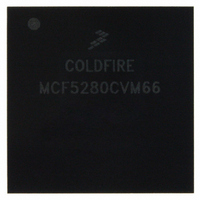MCF5280CVM66 Freescale Semiconductor, MCF5280CVM66 Datasheet - Page 417

MCF5280CVM66
Manufacturer Part Number
MCF5280CVM66
Description
IC MPU 32BIT COLDF 256-MAPBGA
Manufacturer
Freescale Semiconductor
Series
MCF528xr
Datasheet
1.MCF5216CVM66J.pdf
(766 pages)
Specifications of MCF5280CVM66
Core Processor
Coldfire V2
Core Size
32-Bit
Speed
66MHz
Connectivity
CAN, EBI/EMI, Ethernet, I²C, SPI, UART/USART
Peripherals
DMA, LVD, POR, PWM, WDT
Number Of I /o
142
Program Memory Type
ROMless
Ram Size
64K x 8
Voltage - Supply (vcc/vdd)
2.7 V ~ 3.6 V
Data Converters
A/D 8x10b
Oscillator Type
External
Operating Temperature
-40°C ~ 85°C
Package / Case
256-MAPBGA
Controller Family/series
ColdFire
No. Of I/o's
150
Program Memory Size
2KB
Ram Memory Size
64KB
Cpu Speed
66.67MHz
Embedded Interface Type
CAN, I2C, SPI, UART
No. Of Pwm Channels
8
Rohs Compliant
Yes
Lead Free Status / RoHS Status
Lead free / RoHS Compliant
Eeprom Size
-
Program Memory Size
-
Available stocks
Company
Part Number
Manufacturer
Quantity
Price
Company:
Part Number:
MCF5280CVM66
Manufacturer:
FREESCAL
Quantity:
151
Company:
Part Number:
MCF5280CVM66
Manufacturer:
Freescale Semiconductor
Quantity:
10 000
Company:
Part Number:
MCF5280CVM66J
Manufacturer:
Freescale Semiconductor
Quantity:
10 000
Company:
Part Number:
MCF5280CVM66L
Manufacturer:
FREESCAL
Quantity:
151
- Current page: 417 of 766
- Download datasheet (9Mb)
The desired QSPI_CLK baud rate is related to the internal bus clock and QMR[BAUD] by the following
expression:
22.4.3
The QSPI supports programmable delays for the QSPI_CS signals before and after a transfer. The time
between QSPI_CS assertion and the leading QSPI_CLK edge, and the time between the end of one transfer
and the beginning of the next, are both independently programmable.
The chip select to clock delay enable bit in the command RAM, QCR[DSCK], enables the programmable
delay period from QSPI_CS assertion until the leading edge of QSPI_CLK. QDLYR[QCD] determines the
period of delay before the leading edge of QSPI_CLK. The following expression determines the actual
delay before the QSPI_CLK leading edge:
QDLYR[QCD] has a range of 1–127.
When QDLYR[QCD] or QCR[DSCK] equals zero, the standard delay of one-half the QSPI_CLK period
is used.
The command RAM delay after transmit enable bit, QCR[DT], enables the programmable delay period
from the negation of the QSPI_CS signals until the start of the next transfer. The delay after transfer can
be used to provide a peripheral deselect interval. A delay can also be inserted between consecutive
transfers to allow serial A/D converters to complete conversion. There are two transfer delay options: the
user can choose to delay a standard period after serial transfer is complete or can specify a delay period.
Writing a value to QDLYR[DTL] specifies a delay period. QCR[DT] determines whether the standard
delay period (DT = 0) or the specified delay period (DT = 1) is used. The following expression is used to
calculate the delay when DT equals 1:
Freescale Semiconductor
Table 22-10. QSPI_CLK Frequency as Function of Internal Bus Clock and Baud Rate
Transfer Delays
Delay after transfer
MCF5282 and MCF5216 ColdFire Microcontroller User’s Manual, Rev. 3
QMR[BAUD]
QSPI_CS-to-QSPI_CLK delay
QMR [BAUD]
255
16
32
2
4
8
=
Internal Bus Clock = 80 MHz
-----------------------------------------------------------------------------------
2
=
×
32
----------------------------------------------- -
[desired QSPI_CLK baud rate]
×
QDLYR[DTL]
f
sys
=
f
sys
QDLYR[QCD]
------------------------------------ -
QSPI_CLK
f
156.9 kHz
sys
2.5 MHz
20 MHz
10 MHz
1.25 Hz
5 MHz
(DT = 1)
Queued Serial Peripheral Interface (QSPI)
Eqn. 22-1
Eqn. 22-2
Eqn. 22-3
22-13
Related parts for MCF5280CVM66
Image
Part Number
Description
Manufacturer
Datasheet
Request
R
Part Number:
Description:
Manufacturer:
Freescale Semiconductor, Inc
Datasheet:
Part Number:
Description:
Manufacturer:
Freescale Semiconductor, Inc
Datasheet:
Part Number:
Description:
Manufacturer:
Freescale Semiconductor, Inc
Datasheet:
Part Number:
Description:
Manufacturer:
Freescale Semiconductor, Inc
Datasheet:
Part Number:
Description:
Manufacturer:
Freescale Semiconductor, Inc
Datasheet:
Part Number:
Description:
Manufacturer:
Freescale Semiconductor, Inc
Datasheet:
Part Number:
Description:
Manufacturer:
Freescale Semiconductor, Inc
Datasheet:
Part Number:
Description:
Manufacturer:
Freescale Semiconductor, Inc
Datasheet:
Part Number:
Description:
Manufacturer:
Freescale Semiconductor, Inc
Datasheet:
Part Number:
Description:
Manufacturer:
Freescale Semiconductor, Inc
Datasheet:
Part Number:
Description:
Manufacturer:
Freescale Semiconductor, Inc
Datasheet:
Part Number:
Description:
Manufacturer:
Freescale Semiconductor, Inc
Datasheet:
Part Number:
Description:
Manufacturer:
Freescale Semiconductor, Inc
Datasheet:
Part Number:
Description:
Manufacturer:
Freescale Semiconductor, Inc
Datasheet:
Part Number:
Description:
Manufacturer:
Freescale Semiconductor, Inc
Datasheet:











